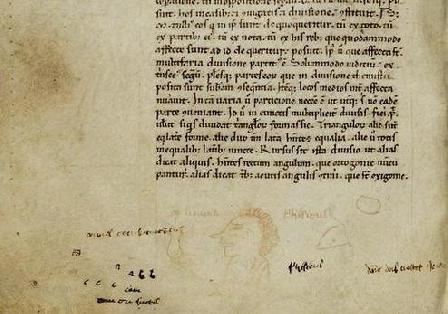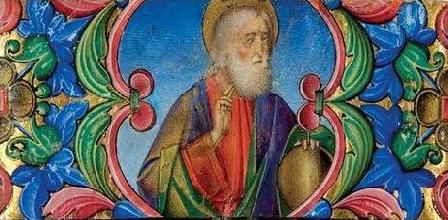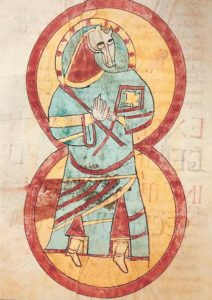Auction Bloomsbury (mars 2008) : \”Exemplari\”, \”trattato dell’ abbaco\”, Livre d’ heures …
Bloomsbury Auctions, Inc., New York présente à la vente (sur Ebay) plusieurs précieux manuscrits, dont un exemplari, origine France, copié par un Karolus. Il s’agit peut-être de Charles, copiste cité par R. H. Rouse & M. A. Rouse, Manuscripts and their makers, II, p. 21, comme étant censitaire en 1285 de Saint-Merri. J’ai moi-même lu ce nom dans le Paris AN S 1626/1 qui est un censier de l’abbaye Sainte-Geneviève, daté de 1276: Karolus scriptor (in bordellis)
Les exemplaria servaient de modèle aux copistes et étaient loués pièce par pièce.

Descriptions d’après notices en ligne
[Lot 3B] ARISTOTLE. [Organon.] Composite manuscript on vellum, containing: PORPHYRY. Isagoge; ARISTOTLE. Categoriae, Liber peri hermenias [De interpretatione]; BOETHIUS, Anicius Manlius Severinus. Liber de divisione, De differentiis topicis; ARISTOTLE. Liber topicorum, De sophisticis elenchi, Priora analytica, Posterioria analytica, in Latin. France: mid- and late 12th century and early 13th century]. Decorated manuscript on vellum. 173 ff., complete. Collation: 114 2-68; 7-108 116 125 (of 6, f. 12/1 blank removed); 13-146 158; 16-198; 20-228. Detailed contents: Porphyry, Isagoge ff.1-4 and 11-14v (ff. 5-10v a second copy inserted in the middle of the first gathering); Aristotle, Categoriae ff. 14v-25v; Aristotle, Liber Peri hermenias ff. 25v-31v; Boethius, Liber de divisione ff. 31v-38v; Boethius, De differentiis topicis, books I-III, ff. 38v-53v; Boethius, De syllogismus categoricis, opening sections only, ff. 53v-54v; Aristotle, Liber topicorum ff. 55-97 [a blank leaf, the pair to ff.55, has been removed from the end of this section but there is no gap in either this text or the following]; Aristotle, De sophisticis elenchis ff. 98-117v; Aristotle, Priora analytica, in the Chartres recension ff. 118-149v; Aristotle, Posteriora analytica ff. 150-172v; notes on humors and brief quotations, additions in a 15th-century hand, ff.172v-173v. Six discrete text blocks (200 x 135 mm. and smaller), each ruled in a different pattern of between 29 and 38 lines, written in dark brown or black ink in different small proto-gothic or gothic bookhands. Opening initials of pale red or brown and red, diagrams in text on ff.132v and 138 and in margin of f.3, extensive marginalia in various hands, ranging from detailed explanatory text and diagrams to informal marginal sketches. Modern blindstamped calf over 15th-century bevelled wooden boards, 15th-century French manuscript deed on vellum (written on recto of a folded folio leaf), formerly used as pastedown, at end. Condition: a few wormholes in first leaves, rubbed or stained with some loss to text of ff. 1 and 2, f.106 with repair crossing text, vellum repairs to lower corner of f. 11, outer margin of f. 74 and lower margin of f. 91. Provenance: The individual text blocks are all in French hands, and several of the annotations are in French, providing evidence that the collected manuscript remained in France. Many of the marginalia are seim-effaced A few are dated to the mid-13th century (1240 and 1269). Some of the annotations are unrelated to the text, transcribing for example, the opening of a letter, or recording the receipt of a mattress, but one note, on f. 117v, records payment to a scribe and may relate to the manuscript’s production (Mag[ist]ri karoli scriptoris p[ro] exemplari. ii sol[idi]) (1). — The manuscript deed that was used as a pastedown, dated 1407 and relating to a marriage settlement of Johanette, daughter of Jehan, living at \”Poulorgny,\” suggests that the manuscript was still in France when it was rebound in the fifteenth century. — Count Oswald Seilern (1901-1967, booklabel, sale Christies London, 26 March 2003, lot 3). A remarkable composite manuscript, consisting of a compendium of discretely produced manuscripts, originally from more than one codex, that were assembled in the 13th century to provide the entire corpus of works that make up the Aristotelian Organon (\”The Instrument\”). Organon was the name given by his followers to Aristotle’s six works on philosophical logic, accompanied by Porphyry’s introduction (Isagoge) and the commentaries by Boethius, through whose Latin translation the works were rediscovered and disseminated throughout medieval Europe. This corpus became the basis for the study of logic and the determining influence on scholastic thought. the assemblage of all of these texts in this thirteenth-century volume provides valuable evidence of the revival of interest in and circulation of the fundamental texts of Antiquity during the in the 12th and 13th centuries. The composite nature of the manuscript mirrors the incremental rediscovery of the Aristotelian corpus during the \”Renaissance of the twelfth century\”: the first section contains the works subsequently known as the logica vetus, written in a particularly fine and elegant hand, apparently in southern France in the middle of the 12th century. The quality of the penmanship in this section may have been the inspired the addition of the other texts and possibly ensured the preservation of the volume as a whole. The remaining texts contain the other logical texts of Aristotle, which became known as the logica nova, as they were only recovered in the course of the 12th century. It is not clear whether these other texts were added in a single campaign at a later date, although this seems unlikely, but it is evident that some attempt was made to give them a more uniform look by the addition of the pink-red initials and occasional paragraph marks. The annotations and marginalia attest to the manuscript’s extensive use by various readers from the 13th century and later. Precise clues as to provenance are scarce, most names being illegible or incomplete. The notes include erudite explanatory text and logical diagrams, including one, in a 13th-century hand, which schematically depicts Porphyry’s questions on the status of \”universals\” (the problem that brought forth scholasticism), as well as frivolous sketches: at the foot of f.51v is a labeled sketch of a physician holding a urine bottle, and in the outer margin of f.109 a knight astride his horse. Medieval Aristotle manuscripts of this quality and early date appear rarely on the market.

Lot 16b: North Italy, Lombardy?: early 16th century
An abbacus manuscript, in Italian. Decorated manuscript on vellum. [Italy], 1419. Signed and dated by the scribe, Joh[ann]es de Strasburg, 18 April 1419. 47 leaves: [19 2-48 56 68]. Possibly incomplete at beginning. Written in brown ink in a small upright cursive, single column, up to 51 lines (variable), section headings and paragraph marks in red, marginal initial capitals and table headings with red capital strokes. Catchwords in center of lower margins on final versos. Ten pages with geometrical diagrams (circles and triangles). Signed and dated at end \”facto e chompiuto adi 18 April 1419 / [in red] Qui scripsit scribat et sember cu[m] d[o]m[i]ni vivat / Amen solamen Steyg der blin uff den lamen / Joh[ann]es de Strasburg\”. Modern black goatskin. Condition: First leaf wrinkled and with large stain obscuring one to two words each from 7 lines on recto, occasional small stains Provenance: \”Piero (?)Strozzo,\” contemporary ownership inscription at end (of a member of the Florentine banking family?); several illegible or partly eradicated early inscriptions on final verso. — Later manuscript notes with geometrical diagrams on 5 leaves at end. a very fine example of a \”trattato dell’ abbaco\” or italian pedagogic manual of commercial mathematics, accounting and geometry. Beginning in the thirteenth century the rise of international trade and banking companies in the Italian city-states prompted the formation of vernacular schools in which commercial mathematics, accounting and writing were taught to sons of the merchant class. This was a radical departure from the humanist educational curriculum, which, if it included mathematics at all, was limited to classical or medieval Latin mathematics – algorisms for determining moveable feast days in the church calendar, or Euclidean geometry. Known as abbaco, this practical course of mathematics was recorded and transmitted in manuscript books, of which several hundred are known to survive, all in Italian, and the vast majority in institutional collections. Long thought to be abbreviated vernacular versions of the Latin Liber abbaci of the 13th-century mathematician Leonardo Fibonacci, an encyclopaedia of practical mathematics, these abbaco manuscripts, of which the earliest dated example is from 1290, may in fact derive from a more widespread culture of commercial mathematics, already known by Fibonacci, and probably flourishing in Provence and/or Catalonia before reaching Italy. From the fourteenth to the sixteenth century so-called abbaco schools flourished throughout northern Italy, in different forms, with the Florentine version being a separate two-year course of study administered to boys aged 11 to 14, while other towns integrated the abbaco teaching into the vernacular schools. The present manuscript opens with problems of addition, multiplication, and division, including fractions. (\”Abbaco books. did not usually explain addition and subtraction, probably leaving this to the teacher to do\” – Grendler, p. 313). It proceeds quickly to \”the heart of abbaco. solving the mathematical problems of business. The ordinary abbaco book might contain four hundred problems and their solutions, of which the largest group by far were business problems (op. cit., p. 314). This manuscript is no exception. The many problems, most presented in a literary, story-telling form that is typical of the genre, relate to commercial arrangements, payment of merchandise, commercial partnerships, measurements and weights, money exchange, etc. Several schematic tables show how to calculate distances; others show different accounting methods or methods of calculating interest. A few other problems are of the \”recreational\” sort described by Grendler, designed to exercise purely mathematical skills. The final section, illustrated with neat diagrams, is devoted to practical geometry. Like all abbaco manuscripts, this one contains a trove of information on late medieval Italian commercial practices. The fact that the manuscript is signed and dated adds to its interest and documentary value. The concluding jingle of the scribe Johann from Strassburg is written in an unusual mixture of Italian and German. Written in the lower margins in a seventeenth- or eighteenth-century Italian hand, the later notes testify to the manuscript’s continued use two or three centuries after its production. Abbaco manuscripts appear very rarely on the market. Cf. Paul F. Grendler, Schooling in Renaissance Italy (Baltimore & London 1989), chapter 11, \”Learning Merchant Skills\”; Warren Van Egmond, Practical Mathematics in the Italian Renaissance: a Catalog of Italian Abbacus Manuscripts and Printed Books to 1600 (Florence 1981). Cf. Paul F. Grendler, Schooling in Renaissance Italy (Baltimore & London 1989), chapter 11, \”Learning Merchant Skills\”; Warren Van Egmond, Practical Mathematics in the Italian Renaissance: a Catalog of Italian Abbacus Manuscripts and Printed Books to 1600 (Florence 1981).
ILLUMINATED MANUSCRIPT LEAVES , France,15th Century. Three leaves from a noted Missal , in Latin, on vellum. [France, ? Britanny, c. 1430s]. each (310 x 230 mm). Double column, 30 lines in black ink in an upright gothic bookhand between 4 verticals and 31 horizontals ruled in grey, one leaf with respectively 9 and 10 lines of musical notation on verso, in square neumes on four-line red staves. Rubricated in red, one heading in gold. Guide letters for rubrics in margins. Numerous illuminated initials in various sizes: three large initials in blue or red on burnished gold grounds with red or blue infill and white penwork decoration, 43 three- to one-line initials in gold on blue and red grounds and with gold, blue and red foliate infill, three line-fillers or Greek crosses in blue or red on gold grounds. Three pages including the page with music with bar borders in burnished gold and pink or blue and with full illuminated borders of acanthus leaves and flowering naturalistic plants in red, blue, green, or gold and hairline tendrils in black ink terminating in gold disks, flower buds and trefoils. Condition: a few small marginal holes and some holes in text block caused by acidic ink. Provenance: Cornelius J Hauck Collection, sale Christies New York, 27th June 2006 lot 104. These leaves were part of a lavishly decorated Missal. The style of the border decoration, particularly the use of orange and liquid gold fruits, evokes the illuminator known as the Master of Margaret of Orléans (duchess of Brittany), and the manuscript may have been produced in Brittany. The leaves contain the opening of the Introit Benedicta sit sancta trinita for Mass on Trinity Sunday, the Introit Resurrexi et adhuc tecum for Mass on Easter Sunday, and the Preface Per omnia secula seculorum from the Canon of the Mass.
BOOK OF HOURS, use of Rouen, in Latin. Late 15th Century Northern France (probably Rouen), [c. 1470-80 and c. 1520]. Illuminated manuscript on vellum. Small 4to (160 x 110 mm). 236 leaves, 1 blank, complete, red ink foliation skips a leaf between fols.86 and 87, ruled in red ink, 25 lines, written-space 112mm. by 70mm.
Bloomsbury Auctions
Site web [Link]
Leave a comment
Pages
Auteur du blog : Jean-Luc DEUFFIC

Commentaires recents
- dans Le livre d’heures et de raison de Maximilien Turpin, conseiller à la Gouvernance de Lille ( † 1704)
- dans Un ami nous a quitté: Gwenaël Le Duc (12 octobre 1951- 24 décembre 2006)
- dans René de Chasteaubriant (+ ca 1500), chevalier pèlerin pour la Terre Sainte, comte de Guazava au royaume de Fez
- dans René de Chasteaubriant (+ ca 1500), chevalier pèlerin pour la Terre Sainte, comte de Guazava au royaume de Fez
- dans Le «Maître du Policratique de Charles V» : un enlumineur breton ?
Visites depuis 10/03/2020
- 5
- 37
- 705



